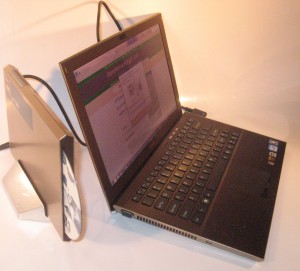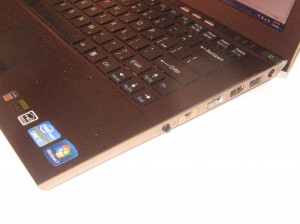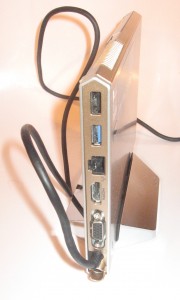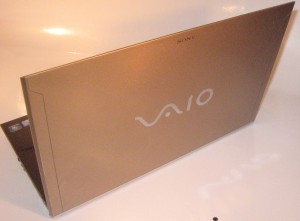Introduction
I am reviewing Sony’s VAIO Z-Series which is their top-shelf ultraportable computer and a model that courts the Apple MacBook Air or the high-end Ultrabooks. This gold-finished variant uses a “split-personality” setup where it can gain extra functionality through a supplied docking station that houses discrete graphics, a power-supply and what’s more, a slot-load Blu-Ray reader / DVD burner.

Price
– this configuration |
AUD$3999 |
|
| Processor |
Intel i7-2640M |
|
| RAM |
8GB |
shared with graphics |
| Secondary Storage |
256GB solid-state drive |
SDHC and MemoryStick card readers, Blu-Ray reader / DVD burner in external module |
| Display Subsystem |
Intel HD graphics |
AMD Radeon HD 650M with 1Gb display memory in external module |
| Screen |
13” widescreen (1920×1080) |
LED-backlit LCD |
| Network |
Wi-Fi |
802.11a/g/n |
|
Ethernet |
Gigabit Ethernet,
Gigabit Ethernet on external module |
|
Bluetooth |
3.0 with HS |
| Connectors |
USB |
1 x USB 2.0, 1 x USB 3,0
1 x USB 2.0, 1 x USB 3.0 on external module |
|
Video |
VGA, HDMI
VGA, HDMI on external module |
|
Audio |
3.5mm audio out, digital out via HDMI
digital out via HDMI on external module |
| Operating System on supplied unit |
Microsoft Windows 7 Professional |
|
| Windows Experience Index – with docking module |
Overall: 6.3 |
Graphics 6.3
Advanced Graphics:6.3 |
The computer itself
The Sony VAIO Z Series is available in two versions – a gold-finished variant which is supplied with an extended-functionality “docking-station” unit a cheaper black-finished unit which has the docking-station unit available for AUD$699 extra

The VAIO with the optical-drive docking station
This docking-station unit has the AMD Radeon discrete video chipset as well as a Blu-Ray reader / DVD-burner drive in it and has a Gigabit Ethernet connector and two USB connectors on it. It connects to the computer using a single cable that plugs in to the right-hand side, where it can also power and charge the computer. Here, you have to make sure you press an “undock” button on the plug and wait for a blue light to turn off before you unplug this plug. It even stands on a gold-plated vertical stand which emphasises the market position that this computer is targeted for.
Aesthetics and Build quality
The VAIO Z Series aesthetics is very similar to a lot of the 13” “thin-and-light” ultraportables and the “champagn-gold” finish for this model that I am reviewing makes it look the part even in a business hotel’s lounge. There is still the good build quality associated with all of the Sony VAIO computers in this model.
As for overheating, the computer is well-ventilated to avoid this problem and the use of integrated graphics and outboard discrete graphics cuts down on this problem.
User interface
The VAIO Z Series comes with an illuminated chiclet keyboard but the illumination is more subtle than most similar implementations, more like what you see with luminous watches. It can still allow full touch-typing but could benefit from the home keys being made easier to find by feel and the keys have the hard-plastic feel about them.
The trackpad has a rough-textured area to move the cursor with and smooth-textured selection buttons. This makes it easier for one to operate the Sony VAIO’s trackpad by feel.
Audio and Video
 The video setup in the Sony VAIO Z Series is very unique amongst laptops. Here, it would work with the Intel HD integrated graphics in a standalone environment or, if it is connected to the Blu-Ray module, it can work with an AMD Radeon discrete chipset in that module. The USB 3.0 link allows the use of the laptop’s screen and video connections or the video connections on the Blu-Ray module.
The video setup in the Sony VAIO Z Series is very unique amongst laptops. Here, it would work with the Intel HD integrated graphics in a standalone environment or, if it is connected to the Blu-Ray module, it can work with an AMD Radeon discrete chipset in that module. The USB 3.0 link allows the use of the laptop’s screen and video connections or the video connections on the Blu-Ray module.
The setup that Sony has worked on for the VAIO can let it become a high-flying high-performing laptop for business, gaming and beyond as well as a battery.conserving laptop for basic tasks on the road.

Right-hand side connections - headphone, Ethernet, HDMI, USB 2.0, USB 3.0, power
glossy screen which may be of concern in bright environments but the darker bezel surrounding the screen does make for improvements in improving the display’s legibility.
The audio subsystem is different in that it just uses the Intel HD audio chipset whether on the Blu-Ray module or standalone. The internal speakers are likely to distort on high frequencies too easily and this can be a problem with smaller laptops. I would improve on this design with a discrete sound subsystem like Creative Labs SoundBlaster in the Blu-Ray module and fit audio inputs and outputs to that module for better sound quality.
Connectivity and Expansion
The idea of the docking station that is part of the VAIO Z Series has permitted Sony to provide a highly-functional computer which suits different applications. Here, you have one USB 2.0 and one USB 3.0 connector on the computer as well as the VGA and HDMI video outputs and Ethernet socket. But this level of connectivity is replicated on the Blu-Ray docking station with the ability to connect peripherals to both devices.
The USB 3.0 port can be set up to provide charging power for gadgets when the laptop is off in a similar vein to what the Toshiba laptops that I reviewed offer.

Docking Station connections - USB 2.0, USB 3.0, Ethernet, HDMI, VGA, computer cable, power
Battery life
The battery is able to last for around five hours of continuous stand-alone use due to the laptop using just the integrated display in that mode. If it is playing optical discs, it would be done on external power due to the Blu-Ray external module becoming the laptop’s power supply.
Limitations and Points Of Improvement

Lid view
One point of improvement that I would see for the VAIO’s Blu-Ray docking modules would be to enable one or all of the USB ports on the docking station to be powered charging ports. This is irrespective of whether the laptop is connected to the docking station or not, so as to allow one to power or charge a mobile phone or similar gadget from this device at all times. The function could be selectively enabled through the use of a hardware switch on the side of the docking module.
Similarly, the Sony’s docking module could house an advanced audio subsystem like Creative SoundBlaster and have audio connections to allow the VAIO to yield Sony’s high-quality audio standards with a nice set of speakers.
For that matter, the idea of an advanced-function docking station that Sony implemented with the VAIO Z Series could be taken further with a micros hi-fi system, home-theatre system or AV component that integrates this functionality in the same chassis. Sony could then take this concept across all of the VAIO “thin-and-light” computer series and use a connection like the new “Thunderbolt” connection for these enhanced-functionality modules.
A cheaper “Fairlane-grade” variant of the Z Series black-finished variant could benefit from a 320Gb regular hard disk that is assisted with a 20Gb solid-state drive implemented for quick-start behaviour. This is becoming a trend for some of the Ultrabooks so as to provide for lower price points and granular model lineups.
Conclusion

Doesn't look out of place in that business hotel's lounge
The prices that are set for the Sony VAIO laptop make it appealing for the “Rolex-class” of businessman who wants an ultraportable that shows the wealth. But the concepts that are espoused in this model could be implemented in the Ultrabook class of thin-and-light ultraportables.
It may be worth thinking that If I were to buy the black version of this model, I would use the docking-station module that is optional for that model as leverage for the deal.







